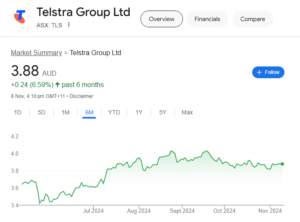Should You Buy Telstra (TLS) for the Dividend or for Growth in the Business?

Telstra’s dividend strategy has long been a cornerstone of its appeal to the shareholders. As one of Australia’s largest telecommunications providers, it operates a stable business model centred on delivering essential services. Its mobile and broadband are some of the widely used services in Australia. Its stability in performance along with regular dividend payments, makes Telstra a preferred choice for income-focused investors.
Telstra’s Business Model and Dividend Strategy
Telstra has achieved a solid feat by accomplishing its FY24 goals and initiatives. Telstra’s mobile network mobile network now reaches 99.7 per cent of the population with over 2.88 million square kilometres of land area covered, an area that represents 37.5 per cent of the continent’s total landmass.
Over the years, Telstra has maintained a consistent dividend payout ratio, currently at around 60-70% of net profit. This payout has been attractive given the company’s large and reliable customer base. Telstra stands to benefit in this regard because of its high customer retention and widespread infrastructure that supports recurring revenue.
In addition, the dividends offered by Telstra are fully franked, allowing investors to benefit from tax credits. This serves as a notable advantage for investors, especially Australian residents in higher tax brackets.

Dividends: Advantages for Income Investors
For income-focused investors, Telstra’s dividend history and future potential remain highly compelling. The company saw great revenue for FY24 at $23.5 billion excluding their finance income. And Telstra’s net profit after tax for the financial year 2024 was a solid $1.8 billion. The company showed an EBITDA of a whopping $7.5 billion for FY24.
Telstra made a significant move by returning over $2 billion to its shareholders and their total FY24 dividends were reported to be 18 cents per share which is fully franked. Its consistent, fully franked dividends mean investors receive tax credits, effectively reducing their overall tax liability. This is particularly beneficial for retirees and those in higher tax brackets seeking steady income.
Telstra’s dividend yield of 4.5% shows a more positive aspect of its performance when compared with the Australian market average. This offers relative stability for the company, especially amid uncertain economic conditions.
Sustaining Dividends: Telstra’s Cash Flow and Profit
Telstra’s capacity to sustain its dividends largely depends on its cash flow. For FY2024, Telstra generated strong cash flows from operations, supported by an underlying EBITDA of $8.2 billion. This cash flow allowed it to fund its dividends without needing significant external financing.
However, Telstra also faces challenges in balancing its dividends with necessary investments in its network operations. As infrastructure grows, the need to stay relevant in the competition in the telecommunications sector is crucial. Telstra’s underlying return on invested capital was stated at 8.3% for the financial year 2024. The company with its strategy to sustain its dividends, is making significant strides towards future growth.
Telstra’s Growth Potential
Apart from the stable dividend outlook, growth-focused investors may find Telstra’s long-term strategic investments to be attractive:
5G Network Expansion
Telstra’s aggressive 5G network expansion is a core part of its growth strategy. The company’s focus on improving mobile speeds, capacity, and connectivity aligns with the increasing demand for mobile data and connectivity across Australia. By leading in 5G, Telstra aims to capture a more profitable business where consumer demand drives the services. This creates a competitive edge for Telstra with other players in the telecommunications industry.
Telstra InfraCo
One of the biggest moves in the telecommunications sector of Australia was when Telstra laid almost 14,000km of high capacity, ultra-low latency fibre across Australia to build Telstra InfraCo’s intercity fibre network. This initiative connects major capital cities from north to south and east to west. By creating and connecting major access points, Telstra’s InfraCo now become a highly regarded telecommunication network.
Telstra InfraCo, its infrastructure unit, includes high-value assets like mobile towers and a vast fibre network. Telstra InfraCo’s development could provide an additional revenue stream, positively impacting overall profitability.
Digital Services and Business Transformation
Telstra has also diversified into new service areas, such as cybersecurity, cloud services, and digital transformation. These innovative services help Telstra to meet the evolving needs of businesses seeking digital solutions. Telstra is set to receive revenue growth in these segments that could boost the company’s future earnings. Telstra’s current broadband services are now highly sought after by the majority of the population in Australia. Furthermore, their expansion into other major infrastructural fields only makes their footprint larger.
Environmental and Social Commitments
Telstra’s commitment to sustainability includes expanding into renewable energy to offset their consumption. This goal not only aligns with its ESG guidelines but also attracts investors focused on environmentally conscious companies. By 2025, Telstra plans to achieve 100% renewable energy use and reduce emissions significantly. These goals contribute to its long-term brand equity and appeal to investors who are environmentally oriented.
Key Considerations: Dividends and Growth
Market Conditions
Given current market conditions and economic uncertainty, dividends provide a buffer for investors wary of volatility. The stable cash flow generated by Telstra’s core business can mitigate risks and deliver reliable income, particularly when interest rates fluctuate and market conditions are unpredictable.
Interest Rates and Financing Costs
Rising interest rates could impact Telstra’s borrowing costs, potentially influencing its growth investments and dividends. However, Telstra’s established cash flow allows it to continue funding growth projects and dividends even with moderate interest rate increases.
Risk of Dividend Cuts vs. Growth Limitations
While Telstra’s dividends have been stable, future growth may be limited by high competition in Australia’s telecommunication market. If new growth ventures don’t yield the expected returns, Telstra might have to re-evaluate its dividend strategy. However, any slowdown in dividend increases could also signal a need to retain its earnings for growth supporting initiatives.
Risks and Challenges in Telstra’s Strategy
As Australia’s telecommunications market is highly competitive, Telstra faces challenges from rivals offering lower-cost alternatives. This competition could impact Telstra’s customer retention and limit its ability to raise prices for its services, thereby affecting growth.
Telstra has faced rising costs due to ongoing inflation and increased expenses in its network infrastructure ventures. While it aims to cut costs and streamline operations shortly, these additional pressures may impact its profit margins if inflation continues to rise.
Rapid technological changes mean that Telstra must continuously invest to maintain its infrastructure and services, especially in areas like 5G. While necessary for growth, these investments can ultimately use up most of the resources and impact dividend payments for the shareholders if returns are slower.
Should You Invest in Telstra for Dividends or Growth?
As investors with unique financial objectives, it is essential to understand the kind of growth you are looking for before considering any company for your portfolio.
For dividend-focused investors, Telstra remains a compelling choice due to its fully franked dividends, stable cash flows, and established position in the telecommunications industry. Its reliable payouts, even amid economic challenges, is an attractive choice to those prioritizing steady income over high growth.
However, for growth-focused investors, Telstra’s initiatives in 5G expansion, its incredible InfraCo initiative, and digital services show a long-term growth trajectory. Although this growth may be slower than in other high-growth tech sectors, investors can consider this venture of Telstra as a valuable addition to their portfolio. Telstra’s commitment to sustainability and infrastructure investment is a great appeal for those interested in solid growth within a stable, blue-chip company.
What are the Best ASX Stocks to invest in right now?
Check our buy/sell tips
Blog Categories
Get Our Top 5 ASX Stocks for FY26
Recent Posts
Develop Global Wins $200m OceanaGold Contract- What It Means for Investors
Develop Global (ASX: DVP) climbed 4% to A$4.36 on Friday after securing a A$200 million underground development contract with global…
Nova Minerals Drops 14% on $20m Capital Raise- Buy or Avoid?
Nova Minerals (ASX: NVA) dropped nearly 14 per cent to A$0.90 following the announcement of a US$20 million (approximately AUD…
WiseTech (ASX:WTC) Rises After Richard White Cleared of Misconduct – Should You Buy the Dip?
WiseTech Global (ASX: WTC) climbed 3 per cent to A$70.18 on Friday after founder and Executive Chairman Richard White was…



